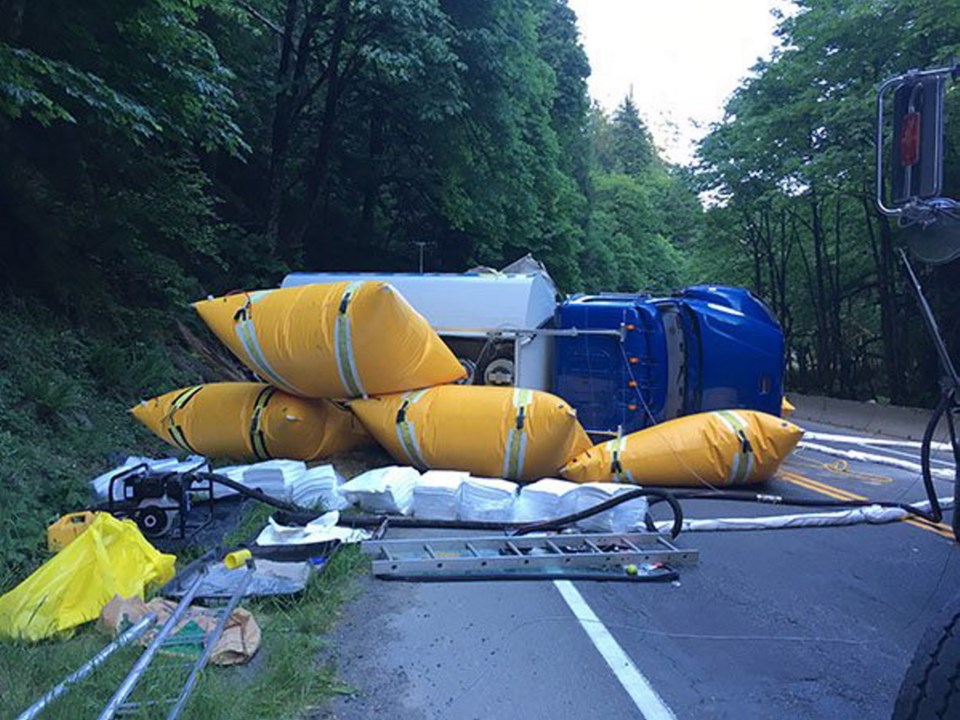Route closed in both directions while fuel truck was cautiously pumped out and police investigated crash
The cautious pumping out of a leaking fuel tanker truck lying on it side and the need for police to investigate led to the nearly 14-hour closing of the Trans-Canada Highway at Goldstream Provincial Park, officials said Friday.
From about 11 a.m. Thursday to 12:30 a.m. Friday, the highway was closed to traffic in both directions just south of Finlayson Arm Road, blocking a road used by 25,000 motorists a day — the only time-efficient route to travel between Victoria and up-Island.
A truck carrying home-furnace fuel and gasoline collided with a courier van, seriously injuring the van driver.
The fuel truck driver was reportedly able to walk away from the scene.
Police have not commented on what caused the crash.
During a conference call, B.C. Environment Ministry officials gave this account of what happened after the collision:
Because of the danger presented by the truck’s cargo, cleanup workers approached the scene in protective fire suits.
Using a sparkless drill, they made holes in the tanker and inserted hoses to pump out the fuel chambers. The fuel was transferred to other tanker trucks.
Monitoring gear detected a leak in a tanker compartment containing gasoline. Langford firefighters and a contracted expert plugged a crack and the work continued.
Some home-heating fuel, similar to diesel, leaked onto the highway shoulder.
Nearby culverts were blocked off to make sure the fuel didn’t travel any farther.
At least three times, workers walked the length of nearby Goldstream Creek to make sure no fuel had leaked into it.
John Kervel, provincial environmental response officer, said the Malahat and Tsartlip First Nations were contacted for data from observation wells, to check on whether fuel had leached into the ground.
After the fuel was removed, the tanker truck was righted with the help of airbags and hauled away on a flatbed transport truck.
Police officers examined the scene, gathering evidence to help reconstruct how the crash happened.
Kervel said the Environment Ministry is waiting for manifest papers that document the tanker’s load. That information will be compared with the volume of fuel recovered. The difference should answer how much fuel was spilled into the environment.
Officials have initially estimated that five litres of fuel was lost, along with a small amount of fluids from the truck.
Langford Fire Chief Chris Aubrey, whose department responded to the crash, said the tanker’s load was listed at approximately 2,200 litres of home-heating fuel and 2,200 litres of gasoline.
The highway closure forced travellers into some extraordinary efforts.
Sooke RCMP reported heavier car traffic on Thursday as motorists travelled through Port Renfrew to the Pacific Marine Circle Route connecting with Lake Cowichan.
RCMP Staff Sgt. Jeff McArthur said he heard the extra traffic meant travelling from Langford to Sooke, normally a 25-minute drive, was taking an hour.
Driving Victoria to Sooke, normally a little over one hour, was taking as much as two hours.
“There was a huge increase in traffic volume that caused us a little grief,” McArthur said.
Other drivers turned to B.C. Ferries, which responded with three extra sailings on the Saanich Inlet run connecting Brentwood Bay with Mill Bay.
There were also additional sailings between Swartz Bay and Fulford Harbour. This allowed travellers to go to Vesuvius Bay terminal on Salt Spring and to sail to Crofton.
Chris Foord, vice-chairman of the Capital Regional District Traffic Safety Commission, said the crash should revive discussions of safer alternatives to the Goldstream section of the Trans-Canada.
With every drop of fuel used in Greater Victoria transported south by tanker truck on the Malahat, perhaps that traffic could be confined to off-peak hours or nighttime, he said.
And it’s a good time to look at building a larger highway, four to six lanes, over the Malahat summit, away from Goldstream park.
“If the objective was to pollute the river, we couldn’t have picked a better location to put the road,” Foord said. “We should bypass Goldstream park, at least the river section.
“Let’s use this occasion to ask: ‘Is there a better place to put the road?’ ”



